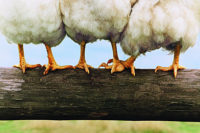There are relatively few industries that haven’t been affected by the country’s current economic troubles, and the poultry industry has been no exception. Large processors have had to face cuts in production and reduced profits, and smaller processors have had plenty of struggles of their own.
“The state of the smaller and mid-sized independent chicken producers/processors is, as it is for essentially all companies in the industry, challenging, economically and financially,” says William Roenigk, senior vice president and staff economist and market analyst for the National Chicken Council.
“The vertically integrated processors have had a difficult year all year long,” says Brad Respess, executive vice president of Marietta, Ga.-based Tip Top Poultry. “They have faced rising grain costs leading to increased feed costs, all associated with the ethanol politics of the current administration. Although this has been a difficult year, we are not vertically integrated; that’s one of the blessings for us.”
Tip Top Poultry is a family-run poultry processor with two plants in
“Our biggest challenges stem from an oversupply of chicken meat in the
While this year hasn’t gone the way that processors hoped, there are hopes for next year. Roenigk says that companies who have survived this long and deep downturn in business can expect next year to be measurably better.
Tip Top Poultry has enjoyed stronger than anticipated retail business this year, with more consumers buying raw chicken and processing it themselves.
“Baking hens are priced by supermarkets as a value item, so that business has performed surprisingly well,” Respess says. He adds that the company’s continued success will be based on the key aspects of quality and service, the things that have allowed the company to stay in business for more than 60 years.
“We strive to make the best products, even when the market isn’t good,” Respess says. “One of our strategic objectives going into 2009 is to deliver award-winning customer service. That, we feel, separates us [from the competition], and it derives value for our customers by keeping their costs of inventory, scheduling, logistics and supply chain down.”
Focusing on service and quality are good ways to keep a business running, Roenigk says, adding that while the organic chicken market may only represent less than one percent of the overall chicken category, it is an excellent example of processors who work well with their customers. “Locally purchased food using more sustainable production methods is becoming more important for many customers,” he says. “Smaller and mid-size companies can often meet this consumer desire more adroitly than the large companies.”
Roenigk notes several areas in the industry with considerable potential growth.
“Despite more challenging economic times, consumers continue to seek a fairly high level of convenience in their chicken products,” he says. “So, the trend toward more convenience will continue, albeit at a more measured pace than in recent prior years.”
Roenigk adds that more consumers are discovering the back of the bird, particularly in legs, thighs and boneless and skinless dark meat.
Hi-tech future
Respess points out that in tougher times, processors have two choices. They can either hold onto their money and wait for things to improve, or that can do what Tip Top Poultry has been doing. “We are currently investing in our business and operations” he says. “We feel that although the market is down, we need to make the hard decision to be investing, so that when the market gets better, we’ll be in a position to capitalize on the opportunities.”
Adding technology to a process also helps combat the available labor issue. Several poultry companies have been raided by the federal government in recent years for employing undocumented workers. Roenigk notes that securing a reliable, documented workforce is one of the biggest challenges, and it won’t go away until the federal government and Congress develop and implement a reality-based solution.
One of the institutions on the forefront of new technology for the poultry industry is the Georgia Tech Research Institute. Craig Wyvill, principal research engineer, says there are several new developments that could greatly impact the industry. Some of the biggest breakthroughs have been in imaging. “We’ve focused on a number of different cells that can be used for anything from whole-carcass screening on the kill line to doing three-dimensional and quality grading of portions, and doing all of them at a very high rate of speed settings,” he says.
That imaging could help determine not only that there are defects in the carcasses, but it may help the processor determine where the damage was originating. Wyvill explains that the data could indicate problems with the stunners or pickers, but the problem had been how that data is handled. If it requires someone to manually pore over the databases and search for potential problems, the benefits aren’t as great.
“One thought was if we could identify problems that related to the pickers or to the stunners and close the loop and make adjustment changes based on what we were seeing, that seemed to be appealing,” he adds. With developments in technology that make those types of automatic changes more feasible, the technology starts to bring a real value into the process.
Another development is screening technology that can measure microbes or chemical compounds that are used in water baths. Wyvill uses the example of a chlorine chiller bath. Traditionally, employees would have to draw samples of the water, take it to a lab and see if there are proper amounts of chlorine. A system that automatically measured the chemical levels in the bath and added chemicals when needed would save all that work and time.
Some of the equipment available to chicken processors are cost-prohibitive to smaller companies, but Wyvill says that they shouldn’t rule out making high-tech investments. Some innovations may be tailor-made for smaller companies, in fact.
“I think that’s where a lot of companies see the opportunities that a lot of bigger guys don’t see,” he reasons. “In many regards, they may not be willing to take a gamble on them, because right now their systems are running very smoothly, and they have very specific, high-volume, throughput targets.
“I would argue that nobody at this point should feel like they can’t [afford new technology]. I think they just need to learn more about it, and maybe collaborate with an equipment company and be the first in getting it into an operation.”
The right technology can help a processor gain that needed competitive edge and stand out in the marketplace.




Report Abusive Comment